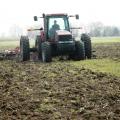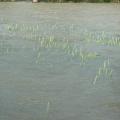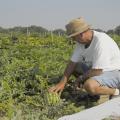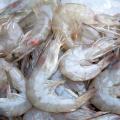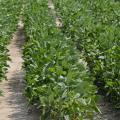Crop Report from 2011
MISSISSIPPI STATE – A drier-than-normal winter has put this year’s winter wheat crop in good shape as it heads into the heavy growth stages of spring.
Erick Larson, grain agronomist with the Mississippi State University Extension Service, said the state has about 300,000 acres of wheat. This figure is up from the meager 125,000 acres harvested in 2010, but down from the recent high of 520,000 acres planted in 2008.
MISSISSIPPI STATE -- With the excitement of drivers at a NASCAR start, farmers are ready to begin the 2011 growing season.
The first fields out of the starting gate are corn fields.
Erick Larson, small grains specialist with Mississippi State University’s Extension Service, said growers were approaching the halfway point in planting this year’s corn crop by the end of March. They should complete planting by the end of April.
By Karen Templeton
MSU Ag Communications
MISSISSIPPI STATE – The strawberry business in Mississippi may be small, but growers are finding big business with consumers who prefer to buy locally.
“The Mississippi strawberry is as red on the inside as it is on the outside,” said Brooks Brownlee, who owns Brownlee Farms in Marshall County and grows five acres of strawberries. “Commercial strawberries have a whitish color and air pockets on the inside, but our berries are fresh-tasting throughout.”
MISSISSIPPI STATE – Crop producers have been busy planting corn, and while those in drier areas are nearly finished, those in wetter areas are trying to catch up.
The U.S. Department of Agriculture estimated the crop was 79 percent planted by April 10. The bulk of the acres yet to be planted are in northeast Mississippi, where frequent rains have kept producers out of soggy fields.
MISSISSIPPI STATE – Mississippi soybean farmers have started planting in spite of unpredictable spring weather that has brought strong wind and heavy rains to some areas while leaving other regions dry.
About 10 percent to 20 percent of the soybean crop is planted.
MISSISSIPPI STATE – The tornadoes of April 27 took a toll on Mississippi’s agriculture, with timber, the state’s No. 2 most valuable agricultural commodity, taking the biggest hit.
Massive storms have swept the state all month, bringing hail, torrential rains and tornadoes. Wednesday was the worst day, with the majority of the damage scattered across the northern part of the state.
MISSISSIPPI STATE -- Farmers were gambling along the Mississippi River long before casinos were built, but as they watch water flood over their fields, all bets are off.
The river is predicted to crest in Vicksburg around May 20 at 57.5 feet, which is 14.5 feet above flood stage and 6 feet above the previous record.
Robert Martin has been watching the mighty Mississippi and its tributaries ebb and flow past Delta fields for 40 years. He is the Sharkey and Issaquena county director for the Mississippi State University Extension Service.
MISSISSIPPI STATE – With all eyes focused on the Mississippi River’s epic floodwaters, catfish producers contemplate its potential impact on their already stressed industry.
Jimmy Avery, aquaculture leader with the Mississippi State University Extension Service, said if the river crests as high as predicted, several catfish farms in the south Delta, particularly those in Sharkey, Issaquena and Yazoo counties may be affected.
STONEVILLE -- Fields along the Mississippi River may be flooded, but the majority of the state’s rice crop is farther inland and needs either more water or time to dry after heavy rains caused other rivers to overflow.
Nathan Buehring, rice specialist with the Mississippi State University Extension Service, said rice fields do not need to be flooded until after the plants are about 6 inches tall. Farmers often will “flush” water over the field to prompt early growth.
By Karen Templeton
MSU Ag Communications
BILOXI – The oyster industry is bracing for extreme losses as freshwater from the Mississippi River flows into the western portion of the Mississippi Sound.
“Oysters are stationary and cannot escape as the freshwater displaces the salt water they need,” said Dave Burrage, professor of marine resources with the Mississippi State University Extension Service. “Oysters just cannot survive long periods of freshwater, so we are expecting significant mortality, maybe even 100 percent.”
By Karen Templeton
MSU Ag Communications
MISSISSIPPI STATE – Despite higher milk prices, the dairy industry struggles to make significant profits because of high production costs and lack of rain.
The current average price for milk is about $19 per hundredweight. In May 2010, the price was $15, up considerably from $11.60 in May 2009.
MISSISSIPPI STATE – About 40 percent of the state’s peanut acres are under extreme drought, and unless rains come soon, it’s going to be a very bad year for the state’s crop.
Mike Howell, Mississippi State University Extension Service peanut specialist, said drought delayed some planting in early May until a timely rain allowed the rest to be planted.
MISSISSIPPI STATE – Mississippi’s sunny skies are producing sweet watermelons and blueberries just in time for Fourth of July tables.
David Nagel, horticulturist with Mississippi State University’s Extension Service, said most of the state’s fruit crops saw very little rain as they approached maturity. Fortunately, many of Mississippi’s commercial watermelon and blueberry plots have irrigation and plastic mulch to help protect plants from droughts.
MISSISSIPPI STATE – They may be living up to their name in size, but Gulf shrimp are being landed in Mississippi in good numbers, and large ones are selling for high prices.
The state’s shrimp season opened May 25, which was about a week earlier than normal. Dave Burrage, marine resources specialist with the Mississippi State University Extension Service, said the early opening was due to Mississippi River flooding.
MISSISSIPPI STATE – The status of the state’s soybean crop depends almost entirely on location, with many east Mississippi fields in good shape while half of Delta fields struggle.
Tom Eubank, a soybean weed scientist and agronomist at Mississippi State University’s Delta Research and Extension Center in Stoneville, said some Delta fields have soybeans setting pods, and others are just being planted.
“In the northern Delta, we have a late crop. In the southern Delta, we have an extremely late crop,” Eubank said. “The more central Delta acres were planted on time.”
By Karen Templeton
MSU Ag Communications
MISSISSIPPI STATE – Mississippi farmers planted another large corn crop, but this year’s corn is suffering from lack of rain.
This season’s plantings are spread over a wide time window because of frequent rainfall north Mississippi. The majority of the crop in the Delta and south Mississippi was planted during late March, but plantings in northern counties were delayed well into May.
MISSISSIPPI STATE -- Mississippi could join Texas, Oklahoma and other southeastern states in widespread shortages of hay and forages if dry conditions continue.
Rocky Lemus, forage and grazing systems specialist with Mississippi State University’s Extension Service, said Mississippi cattle producers are seeing about 50 percent losses of pasture and hay production.
“The southwestern part of the state is very dry. Spotty showers have provided some relief, but much more rain is needed statewide,” Lemus said.
MISSISSIPPI STATE – As summer heat rolls through Mississippi, poultry growers must keep a watchful eye on their cooling equipment yet begin planning for winter.
“The biggest issues growers face are heat in the summer and cold in the winter,” said Danny Thornton, MSU Extension poultry specialist. “Good management practices are the main strategies for dealing with the weather, from maintaining fans and blowers to making sure back-up generators are ready at all times.”
MISSISSIPPI STATE – It’s not the heat or drought but the economy, specifically poor housing starts, that are causing grief for Mississippi’s forestry industry in 2011.
James Henderson, forestry economist and management specialist with the Mississippi State University Extension Service, said the slow economy is hurting the industry.
“There’s no good news for the pulpwood markets, and pine saw timber prices are the lowest they’ve been since the national housing construction downturn started in 2006,” Henderson said.
MISSISSIPPI STATE – Increased consumer interest is positively impacting producers of Mississippi’s truck crops, which include fruits, vegetables, nuts and flowers.
Rick Snyder, vegetable specialist with the Mississippi State University Extension Service, said the rapid growth of the local foods movement has increased demand for truck crops.
“With farmers’ markets in nearly every county of Mississippi, producers no longer have to travel far to find an outlet for their produce,” Snyder said. “Some growers sell at two, three or more markets each week.

